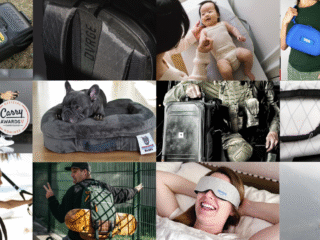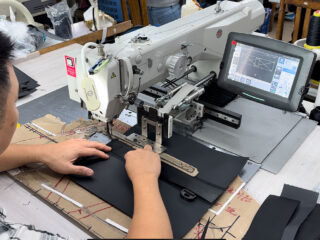Taking a soft goods product to life — whether it’s a travel bag, baby carrier, wearable, or performance gear — starts with a great idea. But to move from sketch to shelf, you need a prototype. Not just any prototype — a functional, manufacturable, and scalable one.
In this guide, we’ll explore the full process of soft goods prototyping, why it matters, what to expect, and how working with an expert like StudioFAR can save you time, money, and costly missteps.
What Is Soft Goods Prototyping?
Soft goods prototyping is the process of transforming your product idea into a physical model made from real or near-final materials. Unlike hard goods, soft goods (think fabric-based products like backpacks, baby gear, apparel, or wearables) involve a unique set of challenges: flexible materials, stitching methods, pattern making, and construction details that impact fit, function, and manufacturability.
A prototype allows you to test your product’s real-world functionality before committing to production. It gives you something you can:
-
Show investors or partners
-
Test with users
-
Refine based on feedback
-
Use for photography, crowdfunding, or marketing
But more importantly — it helps identify design and construction issues before you spend money tooling up for mass production.
Why Prototyping Is Critical in Soft Goods Development
Skipping prototyping — or treating it as an afterthought — is one of the biggest and most expensive mistakes new founders make.
At StudioFAR, we’ve seen clients come to us after spending thousands of dollars on samples that “looked right” but couldn’t be manufactured consistently. That’s because prototyping isn’t just about making something that looks good — it’s about building something that can scale.
During prototyping, we explore:
-
Material behavior: How does the fabric perform when cut, folded, stretched, or stitched?
-
Construction logic: Are seams durable? Do components work together as planned?
-
User experience: Is the product intuitive? Comfortable? Fit for purpose?
-
Aesthetic quality: Does it reflect your brand vision?
This phase uncovers things that renderings and CAD drawings simply can’t. Prototyping is where your assumptions meet reality — and where we adjust to make sure your product is viable for both users and manufacturers.
The Soft Goods Prototyping Process (Step by Step)
1. Concept & Design Translation
We begin by taking your initial idea — whether it’s a sketch, brief, or rough sample — and translating it into a working design. At StudioFAR, this includes aesthetic design, function mapping, material suggestions, and user scenario development. We ensure your concept is not only visually on-brand but built to meet real-world use cases.
2. Patternmaking & Materials Selection
Unlike hard goods, soft goods are sewn — which means creating 2D patterns that will form your 3D product. This is a highly technical skill requiring deep knowledge of construction and materials. During this phase, we also source and specify materials, trims, hardware, and finishes, considering both functionality and production feasibility.
3. Prototype Fabrication
We build your prototype by hand or through a trusted sample development partner. Depending on your product’s complexity, this might take one or more rounds. Each version gives us new insights — about shape, proportions, usability, and manufacturability.
StudioFAR provides detailed feedback loops with each round so you’re part of the process. You’ll see how decisions affect cost, performance, and aesthetics. This is not a “black box” — it’s a collaborative, strategic process.
4. User Testing & Refinement
If applicable, we test your prototype with real users. Whether it’s a wearable device, a baby carrier, or a travel bag, we evaluate how it functions under real conditions. This step is key for refining ergonomics, comfort, and user interaction — often revealing insights you’d never catch in design alone.
5. Design for Manufacturing (DFM) Prep
Every prototype we create is developed with production in mind. That means choosing stitch types your factory can replicate, trimming material waste, and structuring the product for efficient assembly. When prototyping is aligned with manufacturing from the start, you avoid major redesigns later.
Common Soft Goods Prototyping Mistakes to Avoid
-
Skipping the prototype phase entirely
→ Leads to unproven designs and wasted production costs. -
Using unrealistic materials
→ The wrong fabrics may look great but behave differently in production, leading to surprises. -
Working with generalists instead of soft goods specialists
→ Soft goods require unique construction knowledge that typical industrial designers or engineers may lack. -
Assuming your prototype is ready for manufacturing
→ Prototypes are for learning — not for handing off to a factory without further refinement.
Why studioFAR Is the Right Partner for Soft Goods Prototyping
At studioFAR, we specialize in soft goods design and development — which means we understand the unique demands of textile-based products. Led by Fernando A. Robert, a veteran industrial designer with 20+ years of experience across categories like bags, baby gear, wearables, and automotive accessories, our studio is built for founders who want to build things the right way — from day one.
We don’t just make “pretty samples.” We create prototypes with purpose — aligned to real-world use, user feedback, and scalable production. Our process bridges creative vision with technical execution, saving you from expensive mistakes and making your product launch-ready faster.
Whether you’re building your first product or adding to an existing line, our prototyping process ensures you move forward with clarity, confidence, and momentum.
Ready to Build Your Prototype?
If you’re serious about bringing your soft goods product to market, don’t skip the prototype — and don’t settle for a quick-and-dirty sample. Work with a partner who understands every stitch, panel, and production step ahead.
Let’s talk. Book a consultation
We’ll help you go from napkin sketch to sample to scalable, manufacturable product — without wasted time, blown budgets, or preventable setbacks.
https://calendly.com/studiofar/15min




